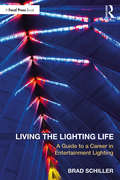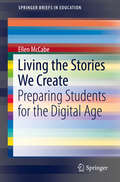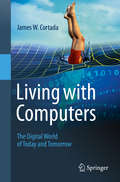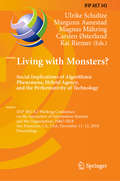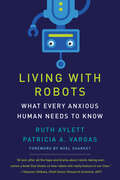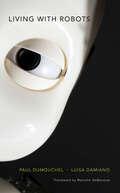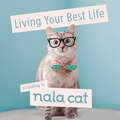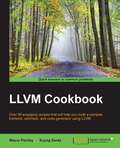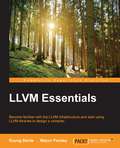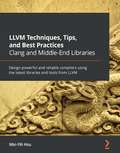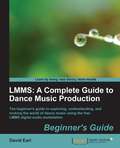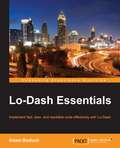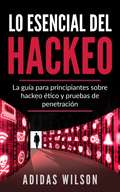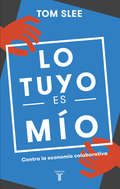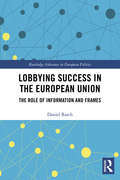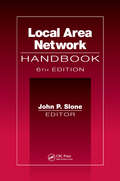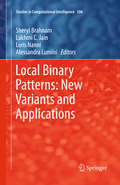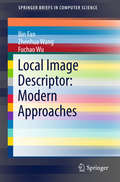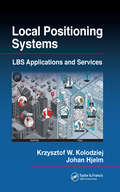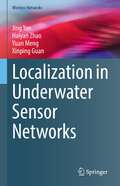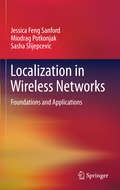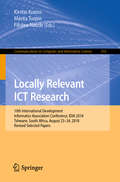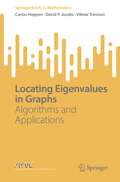- Table View
- List View
Living the Lighting Life: A Guide to a Career in Entertainment Lighting
by Brad SchillerLiving the Lighting Life provides practical tools and advice for a successful career in entertainment lighting. This easy-to-navigate guide offers real-world examples and documentation from the author and key industry experts, giving readers a comprehensive overview of the lighting life. The book provides insight on: Different job opportunities in the entertainment lighting industry; Business procedures, contracts, time sheets, and invoices; Tips on self-promotion, networking, and continual learning; The lighting lifestyle, healthy living, and work-related travel; Maintaining and developing creativity to provide innovative lighting and solutions. With insightful interviews from industry veterans, Living the Lighting Life is a key navigational resource for anyone considering a career in entertainment lighting or just starting out.
Living the Lighting Life: A Guide to a Career in Entertainment Lighting
by Brad SchillerLiving the Lighting Life provides practical tools and advice for a successful career in entertainment lighting. This easy-to-navigate guide offers real-world examples and documentation from the author and key industry experts, giving readers a comprehensive overview of the lighting life. The book provides insight on: Different job opportunities in the entertainment lighting industry; Business procedures, contracts, time sheets, and invoices; Tips on self-promotion, networking, and continual learning; The lighting lifestyle, healthy living, and work-related travel; Maintaining and developing creativity to provide innovative lighting and solutions. With insightful interviews from industry veterans, Living the Lighting Life is a key navigational resource for anyone considering a career in entertainment lighting or just starting out.
Living the Stories We Create: Preparing Students for the Digital Age (SpringerBriefs in Education)
by Ellen McCabeThis work explores the potential of digital media to rectify the disparity between formal learning contexts and contemporary perceptions and expectations of narrative. How can education systems respond to the changing technological landscape, thus preparing students to become active participants in society as well as to realise the extent of their own potential? This book explores such concepts in the classroom environment through direct engagement with students and teachers with the case of Shakespeare's Macbeth. Written in approximately 1606, Macbeth has its roots in a culture of orality and yet has sustained through centuries of print dominance. Indeed, as both text and performance the work itself embodies both the literary and the oral. Yet as a staple of many second level curricula increasingly Macbeth is perceived as an educational text. Macbeth reflects its cultural moment, an age of ambiguity where much like today notions of selfhood, privacy, societal structures, media and economy were being called into question. Thus Macbeth can be understood as a microcosm of the challenges existing in contemporary education in both content and form. This book examines Macbeth as a case-study in seeking to explore the implications of digital media for learning, as well as its possible potential to constructively facilitate in realigning formal learning contexts to contemporary experiences of narrative.
Living with Complexity
by Donald A. NormanIf only today's technology were simpler! It's the universal lament, but it's wrong. In this provocative and informative book, Don Norman writes that the complexity of our technology must mirror the complexity and richness of our lives. It's not complexity that's the problem, it's bad design. Bad design complicates things unnecessarily and confuses us. Good design can tame complexity. Norman gives us a crash course in the virtues of complexity. Designers have to produce things that tame complexity. But we too have to do our part: we have to take the time to learn the structure and practice the skills. This is how we mastered reading and writing, driving a car, and playing sports, and this is how we can master our complex tools. Complexity is good. Simplicity is misleading. The good life is complex, rich, and rewarding -- but only if it is understandable, sensible, and meaningful.
Living with Computers: The Digital World of Today and Tomorrow
by James W. CortadaThe computing technology on which we are now so dependent has risen to its position of ascendency so rapidly that few of us have had the opportunity to take a step back and wonder where we are headed. This book urges us to do so.Taking a big-picture perspective on digital technology, Living with Computers leads the reader on a whistle-stop tour of the history of information and information technology. This journey culminates in a deep exploration into the meaning and role of computers in our lives, and what this experience might possibly mean for the future of human society – and the very existence of humanity itself.In the face of the transformative power of computing, this book provokes us to ask big questions. If computers become integrated into our bodies, merging with the information processing of our very DNA, will computing help to shape the evolution of biological life? If artificial intelligence advances beyond the abilities of the human brain, will this overturn our anthropocentrism and lead to a new view of reality? Will we control the computers of the future, or will they control us?These questions can be discomforting, yet they cannot be ignored. This book argues that it is time to reshape our definition of our species in the context of our interaction with computing. For although such science-fiction scenarios are not likely to happen any time soon – and may, in fact, never happen – it is nevertheless vital to consider these issues now if we wish to have any influence over whatever is to come. So, humans, let’s confront our possible destiny!James W. Cortada is a Senior Research Fellow at the Charles Babbage Institute at the University of Minnesota. He holds a Ph.D. in modern history and worked at IBM in various positions for 38 years, including in IBM’s management research institute, The IBM Institute for Business Value (IBV). He is the author of over a dozen books on management, and nearly two dozen books on the history of information technology. These include the Springer title From Urban Legends to Political Fact-Checking: Online Scrutiny in America, 1990-2015 (with William Aspray).
Living with Monsters? Social Implications of Algorithmic Phenomena, Hybrid Agency, and the Performativity of Technology: IFIP WG 8.2 Working Conference on the Interaction of Information Systems and the Organization, IS&O 2018, San Francisco, CA, USA, December 11-12, 2018, Proceedings (IFIP Advances in Information and Communication Technology #543)
by Ulrike Schultze Margunn Aanestad Magnus Mähring Carsten Østerlund Kai RiemerThis book constitutes the refereed proceedings of the IFIP WG 8.2 Working Conference on Information Systems and Organizations, IS&O 2018, held in San Francisco, CA, USA, in December 2018.The 11 revised full papers presented together with one short paper and 2 keynote papers were carefully reviewed and selected from 47 submissions. The papers are organized in the following topical sections: setting the stage; social implications of algorithmic phenomena; hybrid agency and the performativity of technology; and living with monsters.
Living with Robots: What Every Anxious Human Needs to Know
by Ruth Aylett Patricia A. VargasThe truth about robots: two experts look beyond the hype, offering a lively and accessible guide to what robots can (and can't) do.There&’s a lot of hype about robots; some of it is scary and some of it utopian. In this accessible book, two robotics experts reveal the truth about what robots can and can&’t do, how they work, and what we can reasonably expect their future capabilities to be. It will not only make you think differently about the capabilities of robots; it will make you think differently about the capabilities of humans. Ruth Aylett and Patricia Vargas discuss the history of our fascination with robots—from chatbots and prosthetics to autonomous cars and robot swarms. They show us the ways in which robots outperform humans and the ways they fall woefully short of our superior talents. They explain how robots see, feel, hear, think, and learn; describe how robots can cooperate; and consider robots as pets, butlers, and companions. Finally, they look at robots that raise ethical and social issues: killer robots, sexbots, and robots that might be gunning for your job. Living with Robots equips readers to look at robots concretely—as human-made artifacts rather than placeholders for our anxieties. Find out: •Why robots can swim and fly but find it difficult to walk •Which robot features are inspired by animals and insects•Why we develop feelings for robots •Which human abilities are hard for robots to emulate
Living with Robots
by Paul DumouchelLiving with Robots recounts a foundational shift in robotics, from artificial intelligence to artificial empathy, and foreshadows an inflection point in human evolution. As robots engage with people in socially meaningful ways, social robotics probes the nature of the human emotions that social robots are designed to emulate.
Living Your Best Life According to Nala Cat
by Nala Cat Varisiri MethachittiphanInstagram's most popular feline, Nala Cat, is here to make people smile with her charming guide on how to live your best life.Are you ready to live your best life? Nala Cat, Guinness World Record holder, can teach you how.Nala uses her charm, feistiness, and cute face to spread happiness and love to millions. As an adopted cat, she also uses her social media influence to advocate for shelter animals. Nala's happy, can-do attitude makes her the perfect cat to show us how to love, dream, and be successful in life.Get ready to live your best life with Nala Cat's literary debut, featuring never-before-seen photos and a special Nala-approved guide on the best practices to adopt and take care of a pet.For more warm fuzzies follow @nala_cat
LLVM Cookbook
by Mayur Pandey Suyog SardaThe book is for compiler programmers who are familiar with concepts of compilers and want to indulge in understanding, exploring, and using LLVM infrastructure in a meaningful way in their work. This book is also for programmers who are not directly involved in compiler projects but are often involved in development phases where they write thousands of lines of code. With knowledge of how compilers work, they will be able to code in an optimal way and improve performance with clean code.
LLVM Essentials
by Mayur Pandey Suyog SardaBecome familiar with the LLVM infrastructure and start using LLVM libraries to design a compiler About This Book * Learn to use the LLVM libraries to emit intermediate representation (IR) from high-level language * Build your own optimization pass for better code generation * Understand AST generation and use it in a meaningful way Who This Book Is For This book is intended for those who already know some of the concepts of compilers and want to quickly get familiar with the LLVM infrastructure and the rich set of libraries that it provides. What You Will Learn * Get an introduction to LLVM modular design and LLVM tools * Convert frontend code to LLVM IR * Implement advanced LLVM IR paradigms * Understand the LLVM IR Optimization Pass Manager infrastructure and write an optimization pass * Absorb LLVM IR transformations * Understand the steps involved in converting LLVM IR to Selection DAG * Implement a custom target using the LLVM infrastructure * Get a grasp of C's frontend clang, an AST dump, and static analysis In Detail LLVM is currently the point of interest for many firms, and has a very active open source community. It provides us with a compiler infrastructure that can be used to write a compiler for a language. It provides us with a set of reusable libraries that can be used to optimize code, and a target-independent code generator to generate code for different backends. It also provides us with a lot of other utility tools that can be easily integrated into compiler projects. This book details how you can use the LLVM compiler infrastructure libraries effectively, and will enable you to design your own custom compiler with LLVM in a snap. We start with the basics, where you'll get to know all about LLVM. We then cover how you can use LLVM library calls to emit intermediate representation (IR) of simple and complex high-level language paradigms. Moving on, we show you how to implement optimizations at different levels, write an optimization pass, generate code that is independent of a target, and then map the code generated to a backend. The book also walks you through CLANG, IR to IR transformations, advanced IR block transformations, and target machines. By the end of this book, you'll be able to easily utilize the LLVM libraries in your own projects. Style and approach This book deals with topics sequentially, increasing the difficulty level in a step-by-step approach. Each topic is explained with a detailed example, and screenshots are included to help you understand the examples.
LLVM Techniques, Tips, and Best Practices Clang and Middle-End Libraries: Design powerful and reliable compilers using the latest libraries and tools from LLVM
by Min-Yih HsuLearn how you can build the next big programming language, compiler, or source code analyzer using LLVM and ClangKey FeaturesExplore Clang, LLVM's middle-end and backend, in a pragmatic wayDevelop your LLVM skillset and get to grips with a variety of common use casesEngage with real-world LLVM development through various coding examplesBook DescriptionEvery programmer or engineer, at some point in their career, works with compilers to optimize their applications. Compilers convert a high-level programming language into low-level machine-executable code. LLVM provides the infrastructure, reusable libraries, and tools needed for developers to build their own compilers. With LLVM's extensive set of tooling, you can effectively generate code for different backends as well as optimize them. In this book, you'll explore the LLVM compiler infrastructure and understand how to use it to solve different problems. You'll start by looking at the structure and design philosophy of important components of LLVM and gradually move on to using Clang libraries to build tools that help you analyze high-level source code. As you advance, the book will show you how to process LLVM IR – a powerful way to transform and optimize the source program for various purposes. Equipped with this knowledge, you'll be able to leverage LLVM and Clang to create a wide range of useful programming language tools, including compilers, interpreters, IDEs, and source code analyzers. By the end of this LLVM book, you'll have developed the skills to create powerful tools using the LLVM framework to overcome different real-world challenges.What you will learnFind out how LLVM's build system works and how to reduce the building resourceGet to grips with running custom testing with LLVM's LIT frameworkBuild different types of plugins and extensions for ClangCustomize Clang's toolchain and compiler flagsWrite LLVM passes for the new PassManagerDiscover how to inspect and modify LLVM IRUnderstand how to use LLVM's profile-guided optimizations (PGO) frameworkCreate custom compiler sanitizersWho this book is forThis book is for software engineers of all experience levels who work with LLVM. If you are an academic researcher, this book will help you learn useful LLVM skills in a short time and enable you to build your prototypes and projects quickly. Programming language enthusiasts will also find this book useful for building a new programming language with the help of LLVM.
LMMS: A Complete Guide to Dance Music Production
by David EarlWritten in a step by step tutorial style, learning comes as a result of creating a complete dance music track, along with the explanations that follow each stage. You have a computer and a love for dance and electronic music. Maybe you've been to some clubs, and the energy of electronic dance music has you completely under its spell. You see a DJ spinning, and everyone is dancing. It's infectious. You want to make music that affects people that way. Today the open source community has offered you LMMS. Read this book, and you'll be shown a process to creating great dance music. This book is going to connect the dots if you have already started making dance music, and provide a very solid foundation if you are just getting started - no matter what your skill level is.
Lo-Dash Essentials
by Adam BoduchIf you are a curious JavaScript developer interested simultaneously in tweaking the efficiency of your code, as well as improving the conciseness of it, and maintaining the readability of it, then this is the book for you. Ideally, the book is intended for readers already working on JavaScript projects and using frameworks such as jQuery and Backbone. Even if you're already using Lo-Dash, this book will show you how to use it efficiently. While extensive JavaScript experience isn't a requirement, you should have at least some prior programming experience in order to best understand the concepts presented.
Lo esencial del hackeo: La guía para principiantes sobre hackeo ético y pruebas de penetración
by Adidas WilsonOriginalmente, el término "hacker" se refería a un programador experto en sistemas operativos de computadoras y código de máquina. Hoy, se refiere a cualquiera que realice actividades de piratería o piratería. La piratería es el acto de cambiar las características de un sistema para lograr un objetivo que no está dentro del propósito original del creador. La palabra "piratería" generalmente se percibe negativamente, especialmente por personas que no entienden el trabajo de un pirata informático ético. En el mundo de la piratería, los hackers éticos son buenos. ¿Cual es tu papel? Utilizan su vasto conocimiento de las computadoras para bien y no por razones maliciosas. Buscan vulnerabilidades en la seguridad informática de organizaciones y empresas para evitar que los malos las aprovechen. Para alguien que ama el mundo de la tecnología y las computadoras, sería apropiado considerar una carrera como hacker ético. Pagan (una buena cantidad) para ingresar a los sistemas. Comenzar no será fácil, como en cualquier otra carrera. Sin embargo, si se decide, puede comenzar una carrera lucrativa. Cuando decidas comenzar este viaje, tendrás que cultivar la paciencia. El primer paso para muchas personas suele ser obtener un título en informática. También puede obtener una certificación A + (CompTIA): debe tomar y aprobar dos exámenes diferentes. Para tomar el examen de calificación, debe tener no menos de 500 horas de experiencia práctica en informática. Se requiere experiencia y una calificación CCNA o Network + para avanzar en su carrera. Este libro debería servir como su comienzo en el mundo de la piratería ética. Sería apropiado considerar una carrera como hacker ético. Pagan (una buena cantidad) para ingresar a los sistemas. Comenzar no será fácil, como en cualquier otra carrera. Sin embargo, si se decide, puede comenzar una carrera lucrativa. Cuando decidas comenzar este viaje, tendrás que cultivar la paciencia. El primer paso para
Lo tuyo es mío: Contra la economía colaborativa
by Tom SleeEl primer libro que demuestra que la llamada economía colaborativa -con empresas como Uber o Airbnb- tiene muy poco de colaborativa. Por qué no todo el mundo gana. La idea de economía colaborativa se nos ha contado como una forma alternativa a la economía convencional que no solo resulta más sostenible sino que además permite al individuo convertirse en un microemprendedor con mayor control de su vida. Pero esta nueva ola de empresas está en realidad financiada y dirigida por capitalistas de la más vieja escuela. Tom Slee muestra cómo la economía colaborativa extiende las más duras prácticas del libre mercado a áreas de nuestras vidas previamente protegidas, y ofrece la oportunidad a unas pocas personas de enriquecerse perjudicando a su comunidad y empujando a individuos vulnerables a asumir riesgos insostenibles. Basado en una brillante investigación original, repleta de datos y de ejemplos de los más concluyentes, Lotuyo es mío demuestra que tras un lenguaje amigable basado en las ideas de confianza y compartir, se oculta una realidad muy oscura. Reseñas:«En este libro tan lúcido como riguroso, Tom Slee desmantela la fachada de la economía colaborativa y revela las verdades ocultas e inquietantes sobre compañías como Uber y Airbnb. Si usted quiere entender cómo operan las empresas de Internet en realidad, Lo tuyo es mío es el lugar desde donde empezar.»Nicholas Carr, autor de Superficiales. ¿Qué está haciendo Internet con nuestras mentes? «Un libro magníficamente argumentado.»Steven Poole, The Guardian «Una crítica inteligente y punzante a un modelo de negocio sobre el que la gente apenas está empezando a reflexionar. Con gran acierto, Slee lo analiza como un modelo de negocio que se hace pasar por un movimiento.»Robert E. Levine, The Spectator «Slee, un tecnólogo moderado, ofrece un panorama bien investigado de las empresas cuyo valor de mercado ha crecido notablemente externalizando sus costes y burlando las leyes destinadas a proteger a los consumidores. Este libro es clarividente e importante.»Sue Gardner, ex directora ejecutiva de la Fundación Wikimedia
Lobbying Success in the European Union: The Role of Information and Frames (Routledge Advances in European Politics)
by Daniel RaschHaving information is key for most political decisions – both for decision-makers and societal actors. This is especially crucial in democratic countries where external stakeholders are invited to participate in decision-making pro- cesses. Assuming that every actor that gets involved in decision-making processes has a particular lobbying goal, there is a heterogeneous set of actors competing against each other to provide information to the decision-makers. This competition leads some stakeholders to be more successful in achieving their goals than others. Frames, and the framing of information, play an important role in such lobbying success. In this book, Daniel Rasch questions whether and, if so, how, information impacts lobbying success and shows how various actors perform in three instances of European decision-making. He does so by combining findings from a qualitative content analysis with the results of a cross-case analysis using the quantified qualitative data. The new dataset contains a representative sample of over 200 position papers from EU level and national consultations, press releases and evidence from national stakeholders in Germany, Sweden and the United Kingdom. Lobbying Success in the European Union effectively bridges research on interest mediation and framing studies, and offers a new model for measuring stakeholders’ success. This new and pragmatic approach to study lobbying success using a traceable and easy to use instrument can be adapted to any policy analysis and any issue.
Local Area Network Handbook, Sixth Edition
by John P. SloneToday's enterprise cannot effectively function without a network, and today's enterprise network is almost always based on LAN technology. In a few short years, LANs have become an essential element of today's business environment. This time in the spotlight, while well deserved, has not come without a price. Businesses now insist that LANs deliver vast and ever-increasing quantities of business-critical information and that they do it efficiently, flawlessly, without fail, and most of all, securely. Today's network managers must consistently deliver this level of performance, and must do so while keeping up with ever changing, ever increasing demands without missing a beat. At the same time, today's IT managers must deliver business-critical information systems in an environment that has undergone radical paradigm shifts in such widely varied fields as computer architecture, operating systems, application development, and security. The Local Area Networks Handbook focuses on this collective environment, in which networking and information technology work together to create LAN-based enterprise networks. Topics have been selected and organized with this in mind, providing both depth and breadth of coverage. The handbook will provide you not only an understanding of how LANs work and how to go about selecting and implementing LAN products, but also of how to leverage LAN capabilities for the benefit of your enterprise.
Local Binary Patterns: New Variants and Applications
by Alessandra Lumini Lakhmi C. Jain Loris Nanni Sheryl BrahnamThis book introduces Local Binary Patterns (LBP), arguably one of the most powerful texture descriptors, and LBP variants. This volume provides the latest reviews of the literature and a presentation of some of the best LBP variants by researchers at the forefront of textual analysis research and research on LBP descriptors and variants. The value of LBP variants is illustrated with reported experiments using many databases representing a diversity of computer vision applications in medicine, biometrics, and other areas. There is also a chapter that provides an excellent theoretical foundation for texture analysis and LBP, in particular. A special section focuses on LBP and LBP variants in the area of face recognition, including thermal face recognition. This book will be of value to anyone already in the field as well as to those interested in learning more about this powerful family of texture descriptors.
Local Image Descriptor: Modern Approaches
by Bin Fan Zhenhua Wang Fuchao WuThis book covers a wide range of local image descriptors, from the classical ones to the state of the art, as well as the burgeoning research topics on this area. The goal of this effort is to let readers know what are the most popular and useful methods in the current, what are the advantages and the disadvantages of these methods, which kind of methods is best suitable for their problems or applications, and what is the future of this area. What is more, hands-on exemplars supplied in this book will be of great interest to Computer Vision engineers and practitioners, as well as those want to begin their research in this area. Overall, this book is suitable for graduates, researchers and engineers in the related areas both as a learning text and as a reference book.
Local Positioning Systems: LBS Applications and Services
by Krzysztof W. Kolodziej Johan HjelmLocal Positioning Systems: LBS Applications and Services explores the possible approaches and technologies to location problems including people and asset tracking, mobile resource management, public safety, and handset location-based services. The book examines several indoor positioning systems, providing detailed case studies of existing applications and their requirements, and shows how to set them up. Other chapters are dedicated to position computation algorithms using different signal metrics and determination methods, 2D/3D indoor map data and location models, indoor navigation, system components and how they work, privacy, deployment issues, and standards. In detail, the book explains the steps for deploying a location-enabled network, including doing a site-survey, creating a positioning model and floor maps, and access point placement and configuration. Also presented is a classification for network-based and ad-hoc positioning systems, and a framework for developing indoor LBS services. This comprehensive guide will be invaluable to students and lecturers in the area of wireless computing. It will also be an enabling resource to developers and researchers seeking to expand their knowledge in this field.
Localization in Underwater Sensor Networks (Wireless Networks)
by Jing Yan Haiyan Zhao Yuan Meng Xinping GuanOcean covers 70.8% of the Earth’s surface, and it plays an important role in supporting all life on Earth. Nonetheless, more than 80% of the ocean’s volume remains unmapped, unobserved and unexplored. In this regard, Underwater Sensor Networks (USNs), which offer ubiquitous computation, efficient communication and reliable control, are emerging as a promising solution to understand and explore the ocean. In order to support the application of USNs, accurate position information from sensor nodes is required to correctly analyze and interpret the data sampled. However, the openness and weak communication characteristics of USNs make underwater localization much more challenging in comparison to terrestrial sensor networks.In this book, we focus on the localization problem in USNs, taking into account the unique characteristics of the underwater environment. This problem is of considerable importance, since fundamental guidance on the design and analysis of USN localization is very limited at present. To this end, we first introduce the network architecture of USNs and briefly review previous approaches to the localization of USNs. Then, the asynchronous clock, node mobility, stratification effect, privacy preserving and attack detection are considered respectively and corresponding localization schemes are developed. Lastly, the book’s rich implications provide guidance on the design of future USN localization schemes.The results in this book reveal from a system perspective that underwater localization accuracy is closely related to the communication protocol and optimization estimator. Researchers, scientists and engineers in the field of USNs can benefit greatly from this book, which provides a wealth of information, useful methods and practical algorithms to help understand and explore the ocean.
Localization in Wireless Networks
by Miodrag Potkonjak Jessica Feng Sanford Sasha SlijepcevicIn a computational tour-de-force, this volume wipes away a host of problems related to location discovery in wireless ad-hoc sensor networks. WASNs have recognized potential in many applications that are location-dependent, yet are heavily constrained by factors such as cost and energy consumption. Their "ad-hoc" nature, with direct rather than mediated connections between a network of wireless devices, adds another layer of difficulty. Basing this work entirely on data-driven, coordinated algorithms, the author's aim is to present location discovery techniques that are highly accurate--and which fit user criteria. The research deploys nonparametric statistical methods and relies on the concept of joint probability to construct error (including location error) models and environmental field models. It also addresses system issues such as the broadcast and scheduling of the beacon. Reporting an impressive accuracy gain of almost 17 percent, and organized in a clear, sequential manner, this book represents a stride forward in wireless localization.
Locally Relevant ICT Research: 10th International Development Informatics Association Conference, IDIA 2018, Tshwane, South Africa, August 23-24, 2018, Revised Selected Papers (Communications in Computer and Information Science #933)
by Filistea Naude Marita Turpin Kirstin KraussThis book constitutes the refereed proceedings of the 10th International Development Informatics Association Conference, IDIA 2018, held in Tshwane, South Africa, in August 2018.The 20 revised full papers presented were carefully reviewed and selected from 61 submissions. The papers are organized in topical sections on ICT adoption and impact; mobile education; e-education; community development; design; innovation and maturity; data.
Locating Eigenvalues in Graphs: Algorithms and Applications (SpringerBriefs in Mathematics)
by Carlos Hoppen David P. Jacobs Vilmar TrevisanThis book focuses on linear time eigenvalue location algorithms for graphs. This subject relates to spectral graph theory, a field that combines tools and concepts of linear algebra and combinatorics, with applications ranging from image processing and data analysis to molecular descriptors and random walks. It has attracted a lot of attention and has since emerged as an area on its own.Studies in spectral graph theory seek to determine properties of a graph through matrices associated with it. It turns out that eigenvalues and eigenvectors have surprisingly many connections with the structure of a graph. This book approaches this subject under the perspective of eigenvalue location algorithms. These are algorithms that, given a symmetric graph matrix M and a real interval I, return the number of eigenvalues of M that lie in I. Since the algorithms described here are typically very fast, they allow one to quickly approximate the value of any eigenvalue, which is a basic step in most applications of spectral graph theory. Moreover, these algorithms are convenient theoretical tools for proving bounds on eigenvalues and their multiplicities, which was quite useful to solve longstanding open problems in the area. This book brings these algorithms together, revealing how similar they are in spirit, and presents some of their main applications.This work can be of special interest to graduate students and researchers in spectral graph theory, and to any mathematician who wishes to know more about eigenvalues associated with graphs. It can also serve as a compact textbook for short courses on the topic.
